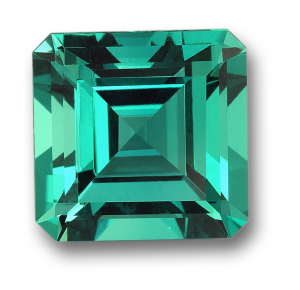The world of precious emeralds is a captivating one. Known as the Stone of Venus and discovered in Cleopatra’s Mines in Egypt in 1600 BC they hold a special fascination for most gemstone lovers. Legend has professed that the Roman Emperor Nero wore glasses with the lens made of emeralds to watch the gladiators fight. It was believed that the color green was very soothing and very easy on the eyes. This belief holds true today. A gemstone can have great value and this value is determined by the 4C’s – color, clarity, cut and carat weight. When evaluating any Emerald the most important of these factors is color.
What color of Emerald stone is best?
The darker and more intense green, all else being equal, the more valuable the emerald. Emerald is one of the varieties of beryl and the finest color of emeralds are said to come from Muzo, Columbia. Emeralds from Muzo although beautifully colored contain more inclusions than Emeralds found elsewhere. These inclusions are usually calcite crystals and are called “jardins” (french for gardens). More recently, good quality emeralds are also sourced from Brazil (Minas Gerais) – whilst the stones sourced from Brazil are less inclined to have inclusions, they tend to be more yellow-green in color (lighter than their Columbian counterparts)
Do Emeralds have Inclusions?
When determining the clarity of an emerald it is important to note that almost all emeralds have inclusions. GIA categorizes three clarity types for colored gems:
Type 1 – gems that are often virtually free of inclusions
Type 2 – gems that are usually included and
Type – 3 gems that are almost always included such as emeralds.
As Type 3 gems, emeralds are expected to have inclusions visible to the naked eye. Therefore, BUYER BEWARE. If a relatively inexpensively Emerald looks inclusion free and totally clean it is quite likely a synthetic.
Are Emerald gemstones enhanced?
As we mentioned, almost all Emeralds have inclusions. So it is common to see the stones oiled to fill cracks, hide some of the stones flaws and enhance its color. The treatment of oiling is used on almost all Emeralds to enhance clarity. There are four grades of oiling – none, minor, moderate and high.
When purchasing an Emerald always ask to see the treatment report (or a get an independent certificate). An Emerald that is “none” grade treatment has far more value than an Emerald in one of the other grades. If an Emerald has been treated with oil, the original oil should be replaced every three to five years.
Carat weight is another factor that affects the value of an emerald. Large, gem quality emeralds are very rare. Obviously larger and cleaner emeralds with deep color can champion a higher price, often higher than that of a comparable diamond.
What is the best cut for Emerald gemstones?
Cut refers to the make of a gem or the way a gem is polished. It is extremely important to have a gem with the proper proportion and symmetry. This will help dictate the beauty and brilliance of the stone. Cutters and setters should always take great pains when working with and fashioning gemstones. This is especially true with emeralds as they are more vulnerable and fragile than other stones. They are 7.5 – 8 on Moh’s scale of mineral hardness. By comparison Rubies and Sapphires are a 9 on Mohs hardness scale and diamonds are 10. However, its not the ‘hardness’ Common cuts for emeralds are faceted emerald cut, rectangular emerald cut and cabochon.
Emeralds can be found in Columbia, Zambia, Brazil, Pakistan, Zimbabwe and Afghanistan. There are a few mines in Columbia that produce a very rare emerald. It consists of six separate crystals that join together and form a star, these are known as “trapiches”. They are highly prized and coveted by collectors.
Caring for emeralds is quite simple. Store them separately from other gems and assembled pieces of jewelry. Never use ultrasonic or steam cleaners. Only clean with soap and warm water.
Some Fun Facts About Emeralds.
1. One of the largest, best and most valuable collections of Emeralds in the world can be found in the Iranian Crown Jewels.
2. Elizabeth Taylor was given a spectacular Emerald necklace from Richard Burton on their wedding day in 1964. It was just auctioned by Christie’s Auction House in New York. The opening asking bid was over one million dollars.
3. The Topkapi Dagger is the world’s most decorated gold sword. Containing three huge emeralds it dates back to the 1700s. It can be viewed today at Instanbul’s Topkapi Palace Museum.
4. The National Museum of Natural History in Washington D.C. houses one of the world’s most famous Emeralds. The Patricia Emerald is 632 carats and is one of the largest gemstone quality emeralds today
5. Emerald is the birthstone for the month of May.
What are the Characteristics of Emerald gemstones?
- Mineral – Beryl
- Specific Gravity – 2.72
- Refractive Index – 1.577 to 1.583
- Dispersion – .014
- Hardness – 7.5 -8
- Optic Character – Uniaxial
- Formation – Hydrothermal & Pegmatites
What is Green Beryl?
Emerald is one of the varieties of beryl and some are colored by small amounts of chromium, some are colored by small amounts of vanadium and some may be colored by a combination of both. Some experts argue that ‘true’ emeralds are those that are colored due to chromium and that those colored by vanadium should technically be termed green beryl. However, this distinction is more a technicality that anything else…

